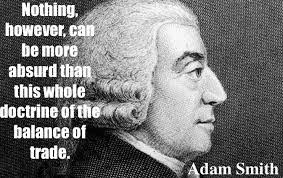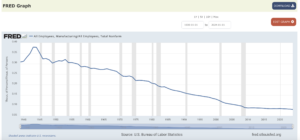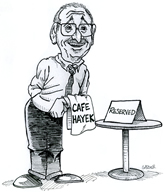Last year, the premier journal Science put a nail in the question: 96% of policies supported worldwide as “reducing” emissions failed to do so, consisting mostly of handouts to green-energy interests.
And yet certain Journal readers still assail me with the epithet “denier.” They confuse my criticism of Democratic hypocrisy with my imagined views on climate science. As I’ve written back to many, “Don’t think politicians haven’t figured this out about you. That’s why they can give us unsustainable corporate welfare boondoggles and call it climate policy.”
A CNN moderator Saturday urged viewers to vote in an online poll on whether the California disaster should be blamed on climate change or poor leadership. Notice the non sequitur: as if climate change is an excuse for not acting against fire risk.
Cait Dexter explains some of the damage that tariffs inflict on small businesses. A slice:
The impact of the Trump administration’s proposed tariffs extends beyond imported goods. Even products made in the US aren’t immune, as heightened costs throughout their supply chains could lead to higher prices for domestically produced items. Take for example Premier Yarns, a popular choice for the fiber arts community — and my yarn of choice. While the yarn itself is manufactured in the US, the raw fibers are often sourced from Turkey, making them one of about 45 percent of businesses that depend on imported raw materials according to the National Association of Manufacturers. Tariffs on these imported fibers could lead to increased production costs, even for yarns produced domestically, affecting everything from pricing to production schedules.
Recent studies offer compelling insights into how tariffs present a complex challenge for small businesses, extending far beyond the crafting sector. A comprehensive study by the National Bureau of Economic Research shows tariffs introduced under the previous Trump administration were borne almost entirely by American consumers and enterprises. These costs disproportionately impact small businesses, who often lack the financial flexibility and resources to absorb increased costs resulting from tariffs, making them more vulnerable to shifts in policy. Reports from the Peterson Institute for International Economics also highlight how tariffs intended to protect domestic industries inadvertently act as regressive taxes that indirectly hurt lower-income consumers and increase production costs for small businesses, stifling their ability to compete both domestically and globally.
Eric Boehm warns Republicans that they might suffer at the polls as a result of Trump’s tariffs. A slice:
A new tariff on that crude oil will be passed along to consumers down the supply chain. Among other things, that likely means higher prices at the pump. The specifics remain to be seen, but analysts believe prices could jump by 40 cents or even 70 cents per gallon. If those tariffs spiral into a broader trade war, energy companies are already warning about “volatility in crude oil prices, impacting refineries and downstream fuel markets, especially for gasoline and diesel.”
One of the major problems with protective tariffs is that they hurt domestic manufacturers because about half of U.S. imports are intermediate goods used for domestic production. The report notes that the International Trade Commission listed manufacturing, apparel, auto parts, computer parts, electronics, and general purpose machinery among the industries most harmed by the tariffs that already exist.
…..
The report illustrates why all of the talk of tariffs in the past several years has been so far afield from the actual economic concerns of the American people. And if tariffs are going to be a part of U.S. economic policy going forward, they should be targeted toward enemies as part of a foreign-policy strategy with measurable goals, not threatened indiscriminately at the president’s whim.
We didn’t take this decision lightly, but the Cfius review failed to meet the most basic requirements of due process and fairness. We believe that Mr. Biden twisted the process to achieve predetermined political ends. (In response to our suit, the White House defended Mr. Biden’s decision and the review as based on the determinations of national-security and trade experts.)
During Mr. Biden’s re-election campaign, the leadership of the United Steelworkers union announced in February that the president had personally assured them that he had their backs as they opposed our deal. He publicly announced his opposition to our partnership in March—before Cfius began its formal review—and received the USW’s endorsement days later.
…..
Cfius’s mandate is protecting national security, and the president can block a transaction only when there is “credible evidence” that a foreign acquirer might take action that “threatens to impair national security.” If electoral politics can dictate the process, it erodes trust in Cfius—threatening the national security interests it was made to guard.
The U.S. has built a welcoming environment for foreign investment, but the world is watching this deal closely. Major companies in allied nations want to invest in the U.S. and employ Americans. Now they wonder if they’ll be treated as partners or political pawns.
GMU Econ alum Adam Michel takes us to tax bootcamp.
An interest-rate cap may seem like a good way to protect consumers, especially low-income ones who find themselves in a cycle of debt they can’t pay off. In 2024, Americans held a collective $1.17 trillion in credit card debt, and in 2022, they paid $130 billion in interest and fees toward their credit cards. But consumer credit is a risky business; many borrowers default or make late payments, and the higher rates are how banks and credit card companies get compensated for taking on that risk. Sanders points out that they make a profit from credit cards—well, they should!
Jeff Jacoby calls for an end to the power of the U.S. president to issue pardons. A slice:
It was naive of me to imagine that the Clinton/Trump abuses would prove exceptions to the rule. President Biden’s deluge of pardons and commutations in recent weeks makes it clear that the old norm is largely defunct. Presidents now are more likely than ever to deploy clemency not to ensure fairness but to thwart it — not as an act of grace to lower the flames of discord but as a political weapon to protect unrepentant allies and reward supporters.
Biden’s sweeping pardon of his son for any and all federal crimes he committed over the past 10 years was disgraceful, and not only because Biden had repeatedly insisted that he would not do it. The pardon also shut down any law-enforcement investigation into Hunter Biden’s alleged influence-peddling activities, which reportedly involved selling access to the Biden “brand” for millions of dollars.


 We do not really know what the balance of trade is, nor does it matter.
We do not really know what the balance of trade is, nor does it matter. [E]ven if every American man, woman and child had equal individual incomes, that would still leave substantial inequalities in household incomes, because households that are in the top 20 percent of income recipients today contain millions more people than households in the bottom 20 percent. These larger households would remain in higher income brackets if incomes were made equal among all individuals. If we restrict income inequality to adult, there would be even more inequality between households, since households consisting of a single mother with multiple children would not have nearly as much income – either total income or income per person – as households consisting of two parents and two children, even if welfare paid the single mother as much as other adults received from working.
[E]ven if every American man, woman and child had equal individual incomes, that would still leave substantial inequalities in household incomes, because households that are in the top 20 percent of income recipients today contain millions more people than households in the bottom 20 percent. These larger households would remain in higher income brackets if incomes were made equal among all individuals. If we restrict income inequality to adult, there would be even more inequality between households, since households consisting of a single mother with multiple children would not have nearly as much income – either total income or income per person – as households consisting of two parents and two children, even if welfare paid the single mother as much as other adults received from working.
 Trump has often complained that China is the biggest beneficiary of the iPhone, just because the devices are often assembled there. But when
Trump has often complained that China is the biggest beneficiary of the iPhone, just because the devices are often assembled there. But when 
